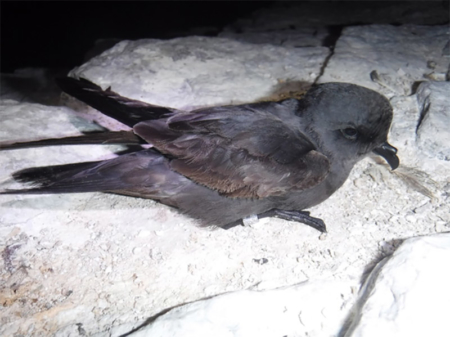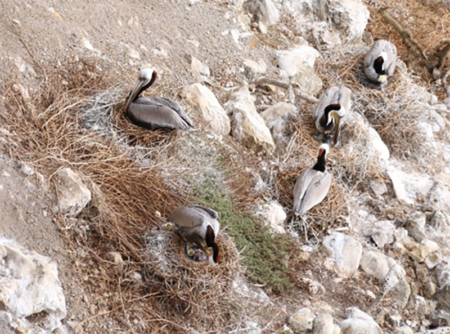Channel Islands
CIES studies and monitors coastal and marine bird communities nesting within the Channel Islands working in partnership with resource management agencies and organizations to inform and guide actions to protect and enhance these important populations. We do this by focusing our work on maintaining long-term databases on population size and reproductive success with emphasis on Scripps’s murrelets, ashy and Leach’s storm-petrels and California brown pelicans. We have been intimately involved in the monitoring, restoration and recovery of pelicans at Anacapa and Santa Barbara islands since the early 1970s. We played a key role in documenting the impacts of black rats on the depleted population of Scripps’s murrelets at Anacapa Island, leading to the successful black rat eradication conducted in 2001-2002 and the eventual recovery of Scripps’s murrelets at this island. We are honored to be playing a key role in monitoring and conserving seabird breeding populations on 6 of the 8 Channel Islands working with numerous partners and collaborators.

Marbled murrelet captured off Newport, OR as part of the Oregon State University Marbled Murrelet Project.
Other U.S. West Coast Projects
CIES has been assisting other partners in conducting research and conservation throughout the west coast of the United States. We have played a key role in capturing endangered marbled murrelets for several studies conducted by Humboldt State and Oregon State universities. These studies have played a key role in understanding the movements, breeding behavior, and diet of this endangered species. We worked with a dedicated group of managers, researchers, and interested NGOs to produce an important management document, Conservation Action Plan for Ashy Storm-Petrels (Oceanodroma homochroa) in California and Baja California, which has been important to helping conserve this endemic species. We have conducted monitoring of storm-petrels in northern California that increased our knowledge about the current breeding range of the ashy storm-petrel and documented a significant decline in the largest Leach’s storm-petrel colony in California at Little River Rock (Humboldt County). In this area, we strive to utilize our expertise to build partnerships which leads to collaboration of applied science and management actions to restore and conserve seabirds and their habitats.
Baja California
CIES has a long history of monitoring seabird populations in portions of Baja California, Mexico. Our longest involvement has been monitoring California brown pelican populations in the Gulf of California, working with UC Davis Dr. Daniel Anderson (professor emeritus) and biologists from the Mexican government (Comisión Nacional de Áreas Naturales Protegidas; CONANP). We have also monitored pelican populations on the Pacific Islands off northwestern Baja California intermittently. In 2007-2008, we conducted surveys and population estimates for the breeding seabirds at islands along the Pacific Coast of Baja California in collaboration with researchers from CICESE (Center for Scientific Research and Higher Education in Ensenada).
Japan
Since the mid-1990s, CIES has been collaborating with Japanese researchers to study seabirds throughout the country. In recent years, we have been working with the Marine Bird Restoration Group to assess the status and distribution of Japanese crested murrelets at Birojima (off Kadogawa, Miyazaki Prefecture) and islands located near Mugi-chō (Tokushima Prefecture). To do this, we have been conducting nocturnal spotlights surveys and nest searches to develop and implement monitoring techniques that effectively measure population trends and reproductive success at important breeding colonies. Our work will result in a better understanding of the status of the colonies where we are working. However, we believe the greatest value will be the use of these techniques at other Japanese crested murrelet colonies which is critical for comparisons of population status between colonies throughout the breeding range in southern Japan and the Republic of Korea.


